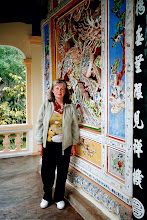
 Image on left - Image of Lorenzo de Medici, a great patron of the arts in Florence in the 1400s, and Michaelangelo's initial patron who introduced Michaelangelo to the Humanists and intellectuals of the day who met at Lorenzo's palace. The Medicis had made their fortune through banking.
Image on left - Image of Lorenzo de Medici, a great patron of the arts in Florence in the 1400s, and Michaelangelo's initial patron who introduced Michaelangelo to the Humanists and intellectuals of the day who met at Lorenzo's palace. The Medicis had made their fortune through banking.Image on right - Staircase designed by Michaelangelo, who was a true renaissance man, excelling in painting, sculpture and architecture. He even designed a library!
" Giulio de' Medici, who had by this time become Pope Clement VII, commissioned the creation of a great library to house the vast Medici collection of books. The design, particularly that of the library's vestibule, is one of Michelangelo's greatest architectural achievements. Its main feature is the spectacular staircase, the idea for which came to Michelangelo in a dream, whose three flights of steps seem almost alive as they cascade downward to fill the vestibule space." a quote from
http://entertainment.howstuffworks.com/arts/artwork/michelangelo-buildings6.htm
Going back in time a bit here, Cassiadorus, and St Benedict both of the C6th, were largely responsible for saving the writings of ancient Greece and Rome, the Benedictine monks copying these classics as well as the work of St Augustine, Jerome, Gregory, and other early church fathers.
The Carolingian (Frankish) Empire (C8th) had a great interest in the preservation of the classics as well.In Byzantium the Greek and Roman classics were preserved, as they were in the middle east and Moorish Spain.
As city-states developed, national identity and languages were respected, hence work was beginning to be translated into vernacular languages. The merchant and tradesman classes began to get prosperous and have more influence, the feudal system gave way to a more modern type of state with commerce as its base. International trading began to influence social concepts.
The rise of university towns from 1200AD saw secular clerics producing books for the students. The effects of the new universities were cumulative and ultimately led to the renaissance. There was an interest in secular subjects as well as theological, and the studying of the ancient texts of Greece and Rome.
Bookmaking and bookselling from 1400AD especially in Venice, Florence, Paris and Frankfurt became a commercial enterprise. Woodblock books were already being printed.
Add to this mix the genious of Gutenberg’s invention of the movable type, and the ability to create the adjustable metal moulds that could cast different sized types accurately and in large numbers. The stage was set for the dramatic changes that swept over Europe at that time. A pre-renaissance had started in the early C14th but the plague which spread across Europe in about 1350’s, stalled this process.
Architecture was being influenced by ancient Greek and Roman styles and proportions, art was becoming more realistic. Michaelangelo and Da Vinci were working in Florence in the late -1400’s- early 1500’s. It was the fall of Constantinople,1453, that was the spark that propelled Europe into the Renaissance. While the Greek scholars poured in to Venice and other Mediterranean countries, bringing their scholarly manuscripts with them, the printing boom was about to hit Italy. The printing of these classics by Italian printers made the information widely available.
The free thinking of this time lead to the flowering of art, architecture and philosophy of the Renaissance, which coincided exactly with the flourishing of the printing press in Italy. By 1500 the Greek and Roman classics were being printed and widely read. New ideas were being brought into the consciousness of Europeans whose philosophy up ‘til now had been dominated by Catholic Christian ideas.
In the 1400s, the humanist movement emerged based on the classical teachings of the inherent goodness of mankind, the respect for nature and scientific enquiry, and more enlightened ideas of man’s place within the world of nature. The Humanists were not enamored of the Reformist movement which placed even more restrictions on people, holding on to the idea that we are sinners whose life is basicly for repentance. The Humanists rejected this negative view of humanity and praised the natural world and man’s place in it.
The printing of books, spreading like wildfire across Europe, brought a huge wave of new ideas and ways of perceiving the world. Secular books and art flourished. Without the printing press, the Renaissance could have affected Europe much less. It was this availability of knowledge to everyone which spurred the rapid changes.
Research process
I have found that by going to "Google images" I can be led, through clicking on the images, to interesting websites I may not have otherwise found. This is an intriguing route.
Once again Britannica proved indispensable and reliable.
Resources
Claybourne, A 2008, The Renaissance, Time Travel Guides, White-Thomson, Lewes, East Sussex.
Renaissance and Humanists, Encyclopedia Britannica Online, viewed 5 May 10













